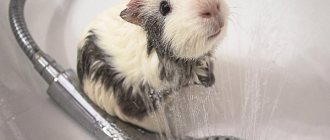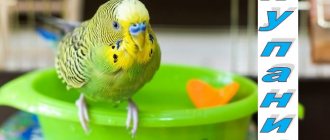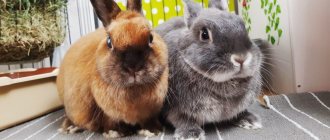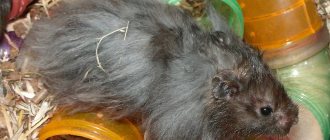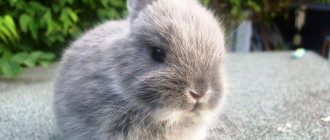The appearance of a playful little rabbit in the house is a great joy for all family members. But do not forget that a long-eared pet is not a plush toy, but a living creature that requires affection, love and proper care. To organize a proper life for an animal, you need to be aware of all the nuances of its maintenance. Hygiene procedures are a very important point.
It is worth noting that veterinarians do not recommend washing a rabbit and do not consider such a procedure mandatory. But sometimes it happens that you can’t do without swimming. This manipulation can be done at home, or you can immediately contact a professional groomer.
Is it possible to wash rabbits
Most experts agree that bathing rabbits should be avoided whenever possible. Many veterinarians insist on the inadmissibility of water procedures for ornamental rodents and cite the cleanliness of the animals and the inevitability of stress during bathing as arguments.
Rabbits really don't like water and diligently avoid it in the wild. But in critical situations, animals show themselves as good swimmers. Before bathing decorative rabbits, you need to understand that this is serious stress for them. In addition, water procedures are harmful to the health of the skin and fur of these rodents.
Water removes the lipid coating from the surface of the epidermis of rodents. This causes dryness and flaking of the skin. Bathing a rabbit can lead to shedding of fur, and the animal itself becomes nervous, even aggressive. There are also opposite reactions, when a pet falls into an unusual apathy.
Important! The fur of rodents of exhibition breeds is more susceptible to damage from water than that of non-pedigreed individuals.
Of course, there are times when cleaning your pet with water is necessary.
The basic principles of this extremely rare procedure:
- Compliance with the sequence of actions.
- Conducting preliminary preparation.
- Using special cleaning products.
- Tenderness, caution.
- Unobtrusiveness.
Experts believe that it is possible to train decorative rodents not to be afraid of water procedures. It is suggested to start washing animals from an early age. Bathing an unprepared rabbit can become so stressful that the animal may die from fear.
Which detergent to choose
Do not use detergents on people. The substances included in their composition can harm the animal. The pet store will advise you on a suitable product. There are several types of detergents available on the market. They are designed for the hygiene of various pets: rabbits, guinea pigs, ferrets.
Shampoo. This specialized detergent should not contain sodium lauryl/laureth sulfate, which are harmful to the health of animals. The shampoo will add shine and silkiness to the animal’s fur and make combing easier.
Spray for hair care. Apply to the fur, avoiding contact with the animal's eyes. It must be gently rubbed with a cloth and then combed out thoroughly. The spray will protect the skin from inflammation and relieve problems with skin parasites. It should be noted that although the spray is an alternative to shampoo, it cannot completely replace it. But this is an excellent solution if it is not possible to bathe the rabbit in water.
Dry shampoo. Like a spray, it is used when there is no water at hand, or the contamination is minor. Dry powder is applied to the coat and then carefully combed out. Make sure that no particles remain on the rabbit's fur. This product absorbs dirt and makes hair soft and shiny.
Do not start bathing if there are tangles in the animal's fur. First of all, they need to be carefully combed. After washing, the chance of getting rid of tangles is very small.
When is bathing necessary?
Washing a rabbit is not easy. If the owner is not sure that he can handle it on his own, it is better to invite a groomer. In any case, bathing animals at home requires the presence of an assistant for backup in order to protect frightened pets from possible injuries.
The main reasons that encourage owners of decorative rabbits to bathe their charges:
- the presence of dirt on the fur after a walk;
- the appearance of fleas;
- severe overheating of the animal;
- the appearance of an unpleasant odor;
- indigestion in a pet;
- contact of harmful chemicals on the animal’s fur coat.
Important! You cannot bathe decorative rabbits more than once every 6–7 months.
When can you start swimming?
If we are talking about an ornamental animal, then cleaning measures are usually started only when the appearance of the animal and the condition of its fur are far from ideal.
This is typical for the following cases:
- in case of severe contamination, when cleaning the animal on its own will take a lot of time or it is very undesirable for its health (for example, if the wool has been in contact with chemical products);
- with diarrhea (trying to get rid of sticky feces, the rabbit may eat its own excrement, which will not have the best effect on its well-being);
- if there is a strong smell of urine (in this case, it is enough to carefully wash only the lower part of the animal’s body and paws if they have been in contact with urine);
- after heatstroke as a result of overheating (cold water will help normalize the furry's condition).
As you can see, in most cases, only partial cleaning of the fur is enough, which will be less stressful for the pet.
Detergents
The skin of long-eared pets is unusually sensitive to the effects of any unnatural products. The slightest irritation of the epidermis in rabbits may well develop into dermatological diseases. And this will lead to fur loss.
Special shampoo for rabbits can be purchased at a pet store. The pH level of this product is designed for the sensitive skin of animals. If products for washing eared pets are not commercially available, they can be replaced with a composition for bathing kittens.
Some shampoos for rodents (such as Stepashka) include a small amount of petroleum jelly. It creates a protective coating on rabbits' fur and gently moisturizes the skin. After using this product, the fur of the animals is easy to comb.
Shustrik pet shampoo contains natural extracts of beneficial herbs (nettle, burdock, rosemary), as well as glycerin, which softens the skin. This product not only washes away dirt, but also relieves minor inflammations, cleanses harmful bacteria, and strengthens the epidermis.
Human wash products should not be used when bathing rodents. The pH levels in humans and rabbits are so different that for pets, using, for example, toilet soap can lead to serious skin burns.
Important! If your pet has even a small wound, you cannot bathe it. It is better to postpone the procedure until the animal’s skin has recovered.
Drying wool
To prevent your pet from becoming hypothermic, it is necessary to dry it as quickly as possible. First, the rabbit is dried with towels, changing them as it gets wet. It usually takes 2-3 pieces to dry. If the animal is not afraid of noise, you can use a hair dryer for further drying. It is placed at a distance of 50 cm from the animal. The speed of air flow and its temperature are set to a minimum so as not to frighten the animal, as well as not to dry out or burn the rabbit’s delicate skin.
During the drying process, you need to comb your pet. For short-haired rabbits, soft brushes with bristles are suitable, while for long-haired rabbits, slicker brushes and combs with rotating teeth are suitable. If the animal is afraid of the hair dryer, let it dry and lick itself. In this case, do not lower the animal to the floor so that the animal does not become hypothermic and get sick.
It is worth noting that bathing long-haired rabbits begins with removing mats with scissors or a mat cutter, and only after making sure of their absence do they begin water procedures. If it is possible to do without scissors, then simply comb out the tangled fur with a furminator or a regular brush. Otherwise, it will be impossible to untangle the tangle that has fallen under water.
After bathing, as a preventive measure, you need to clean your ears and eyes with special lotions. To do this, apply a small amount of product to a cotton swab, evenly distributing it over the cotton pad, and starting from the outer corner of the eye, moving to the inner corner, with a light movement, clean it of impurities. And don’t forget to comb your pet to keep it looking neat.
To summarize, we can say that whether or not to bathe a pet is the owner’s decision. It is important to correctly assess the situation and decide what is best for the animal at the moment. Be sure to take into account the health status of the animal. If your rabbit has a gastrointestinal disorder, the first step is to consult a veterinarian for advice to find out the cause of the disease. And then, based on the animal’s well-being, decide on the issue of bathing it.
Always clean your pet's cage on time. Before walking around the house, remove household chemicals and substances that could stain your furry beauty’s fur coat. Minimize the likelihood of your pet's skin colliding with water. In fact, regular brushing 2 times a week will be quite enough for a rabbit.
Bathing the rabbit is in the next video.
How to bathe decorative rabbits
Like many rodents, rabbits cannot tolerate drafts. It is better to arrange a place for swimming away from open doors and windows. Preliminary preparation for bathing is of great importance for the health of pets.
It is carried out in stages:
- Do wet cleaning of the room.
- Heat the water to room temperature and pour it into a basin.
- Examine the rabbit's skin for damage.
- Assess the length of your pet's claws. If it exceeds the norm, the claws are trimmed to avoid problems when bathing the animal.
In the basin
The container should not be too small. Water is poured into the basin to a level of 3–4 cm, and a little shampoo is added. It is necessary to pay attention to the water temperature - it should not exceed 37°C.
For bathing you will need a jug of clean water for rinsing and 2 warm towels. One will need to dry the animal after bathing, the other will need to wrap it up to keep warm.
Sequence of bathing rabbits:
- the assistant takes the animal in his arms, lowers the hind limbs into the pelvis;
- the owner soaps the contaminated area of the skin with a warm solution from the basin, while it is important to keep the ears, eyes and nose dry;
- the area to be washed is rinsed with warm water from a jug;
- The rabbit is dried and wrapped warmly.
Under the tap
This method is also called mini-bathing. You don't need a bowl of water for it. It is enough to adjust the temperature of the water in the tap to 35–38 degrees, add a little into the sink (up to a level of 3–4 cm). There should be a towel at the bottom of the sink.
Washing is carried out locally - first wetting and then soaping the contaminated area. If the animal behaves calmly, you can distribute the foam over the rabbit's entire body. After a few minutes, the pet is rinsed under running water, dried and wrapped.
Important! Before bathing eared beauties, especially if they have long hair, you need to remove all tangles from their fur coat. If the knots cannot be combed out, you should cut them out with scissors.
Dry method
To clean rabbit fur today, not only ordinary shampoos are used, but also waterless products. They are purchased at pet stores or veterinary pharmacies.
Waterless shampoo or spray is applied to the rabbit's fur, rubbed in with the palm of your hand, then combed out. The product should be sprayed with caution so as not to damage the eyesight of rodents.
Sprays that contain mink oil are especially popular today. They perfectly retain moisture, smooth out fur, and protect the epidermis from dryness. Some anhydrous rodent care products contain antiparasitic substances that help rid pets of fleas and other skin parasites.
For waterless care of rabbits, you can also use the so-called cleaning powder (dry shampoo). This composition not only cleans fur well, but also deodorizes wool, gives it shine and a pleasant smell. The powder is applied to the dirty area, lightly rubbed in, and then the animal is combed out.
Interesting! Waterless pet care products are best used for minor stains.
For a gentle pet - a gentle bath
So, how to wash a rabbit so that this procedure does not harm? First of all, calm your furry pet, pet it, and treat it with a treat. And enlist someone’s help: the rabbit will want to run away during water procedures, it will struggle, snort, and may bite. In addition, the assistant will protect the ears from water getting on them.
Prepare everything you need:
- small basin;
- special shampoo for animals;
- several towels.
Then start swimming:
- Close the windows in the room and check for drafts.
- It is better to bathe a rabbit in a basin. Don't use the shower. Firstly, it will scare the animal; secondly, water droplets can get into your eyes and ears, which is strictly prohibited.
- Heat the water for washing to 36-400C. The animal should not freeze and catch a cold.
- Immerse the rabbit or the contaminated part of its body in water and lather it using a suitable rabbit shampoo. Massaging gently, wash away the dirt.
- Do not wet your rabbit's head, ears, eyes or nose under any circumstances.
- Rinse off the detergent thoroughly. After bathing, the animal will lick itself. Therefore, it is important that shampoo residues do not enter his body.
- After washing, wrap the wet eared ear well in a towel.
The bathing water needs to be heated, otherwise the rabbit may catch a cold.
How to dry your pet properly
Drying a bathed rabbit should be done correctly. First, the animal is dried with a soft towel, wrapped in a second one and left to sit alone for a few minutes.
Next, you can use a warm air stream from a hair dryer to dry. The device must be placed no closer than 5–6 cm from the animal and turned on at minimum power. As the animal dries, you can slowly comb it. A bristle comb is ideal for a short-haired pet; a slicker brush or a comb with sparse teeth is ideal for a long-haired pet.
Important! A hairdryer can only be used if the animal reacts calmly to the sound of the device operating.
If the rabbit begins to worry when the hair dryer is on, it is better to stop using the device. The animal can lick itself perfectly well on its own. But you can’t put it down on the floor; a wet pet can get hypothermic.
Afterwards, be sure to treat the rabbit’s ears with a special lotion. This is very easy to do: apply a little product to the sponge, distribute evenly and clean the ears. You can also clean your rabbit's eyes in the same way.
How to dry your coat after bathing
After bathing the rabbit, it is necessary to dry it thoroughly. If this is not done, then there is a risk that the animal will catch a cold and may even die. To dry the eared fish, wrap it in a towel and then wipe it with dry sheets. In practice, it is permissible to use a hairdryer - it will help dry the animal faster and warm the chilled skin.
But we must not forget that the noise of an electrical appliance is additional stress for the animal. The hairdryer is usually turned on to the lowest setting and directed at the eared animal from a distance of more than 0.5 m, so as not to burn the animal’s delicate skin. When drying, you need to comb the fur using special brushes - this will prevent the formation of tangles.


